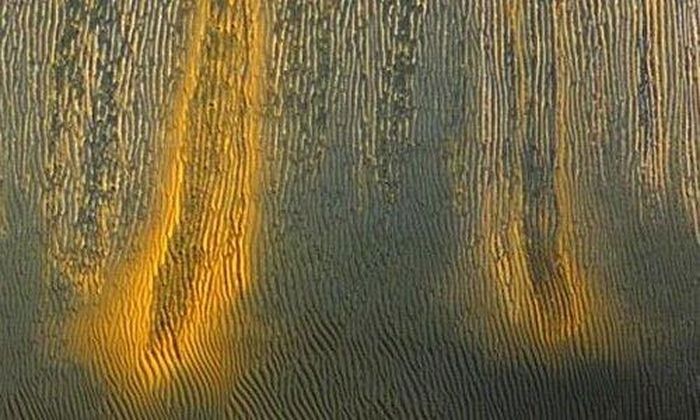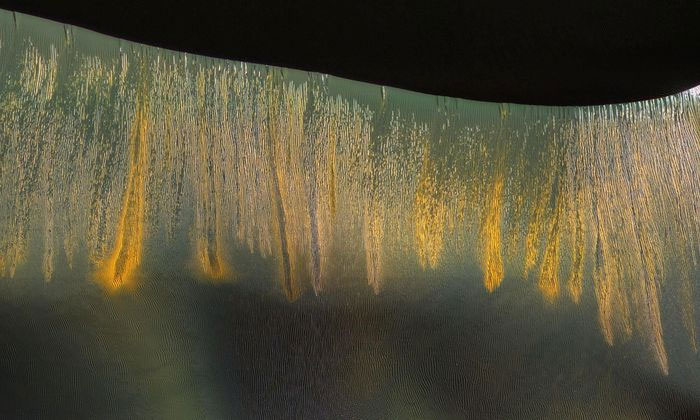Find the strange 'glow' next to the Martian crater
While Mars is known as the red planet, many different colors can be found on the planet's surface. Just like on Earth, the patches of color we can see in images from Mars come from diverse minerals on or just below the surface.

Strange mineral light streaks on Mars.
In this case, due to intense erosion, the minerals below the surface appear strange mineral light streaks with different colors, the team explains from the astonishing HiRISE camera just above. The Mars Orbiter Reconnaissance (MRO).
Here, the MRO has orbited Mars and has captured high-resolution images showing the diversity above and below the Martian surface. Typical is the Kaiser crater region - and the huge dune field inside.
This is a regular target of HiRISE research, so scientists have recognized the seasonal changes taking place in this ever-changing and shifting landscape.
The HiRISE research groups say that the giant sand dunes in the Kaiser crater experience intense erosion of the slopes every year in late winter, when the sun warms these slopes and carbon frosts occur. seasonal dioxide sublimes (meaning it turns from a solid to a gas). Kaiser Crater is located in Noachis Terra, an area on Mars that lies between two giant craters on Mars: Argyre and Hellas.

The huge sand dunes in the Kaiser crater undergo intense erosion of the slopes.
Noachis is so densely covered with impact craters that it is considered one of the oldest landforms on Mars (the term "Noachian" comes from the Earth's name Noah, which refers to one of the oldest landforms on Mars. earliest period).
Mars and Earth aren't the only worlds in the solar system to have these types of fascinating dunes. In fact, Saturn's moon Titan also has the largest unique sand dune in the Solar System. Maybe we'll see those in high resolution when Dragonfly makes a visit to Saturn's largest moon in 2034.
- Artificial intelligence only takes 5 seconds to detect a new crater on Mars
- The Perseverance landing site is an ancient Martian lake bottom, now it's time to find fossils of life
- Enter the crater of Israel to simulate life on Mars
- Discover the second giant crater in Siberia
- 'Martian Gardens - Martian Gardens' helps scientists find a way to grow vegetables on Mars
- See the sharpest color photos of Mars
- Cats glow in the night
- Color beams close to the latest Martian surface
- Asteroid crater is over 2.2 billion years old
- Find meteor craters to kill dinosaurs
- Discover strange things on Mars
- The rover found the scary 'evil eye' on Mars
 Announced 3 houses on the Moon and Mars
Announced 3 houses on the Moon and Mars Science proves: Mars also knows 'deflated'
Science proves: Mars also knows 'deflated' Elon Musk announced the price for a Mars trip was 11.6 billion VND, free of charge
Elon Musk announced the price for a Mars trip was 11.6 billion VND, free of charge NASA discovered strange 'gate' on Mars, is the hiding place found?
NASA discovered strange 'gate' on Mars, is the hiding place found?